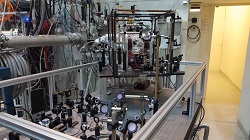Making diamond atomic defects practical for quantum networking
Silicon- and tin-vacancy centres are defects in the crystal lattice of diamond. The unique properties of these bright, narrowband optical emitters, which consist of a silicon (or tin) atom replacing two neighbouring carbon atoms of the diamond make them excellent candidates as qubits. “Atomic impurities within diamond can process information using their spin, a property akin to a small magnet tied to the atomic defect and governed by quantum mechanics,” notes Benjamin Pingault, coordinator of the COHESiV project that received funding from the Marie Skłodowska-Curie Actions programme(opens in new window).
Mechanical vibrations mediating information transfer
The spin of silicon-vacancy centres can encode information from photons. Once encoded, the information needs to be processed and shared with other spins. But how could this information transfer amongst other qubits take place? The answer lies in the unique sensitivity of these centres to vibrations in the diamond lattice. As Pingault elucidates: “our goal has thus been to generate vibrations in a controlled manner. By doing so, we can use them to control the spin of silicon-vacancy centres and facilitate interaction with other spins.” Mechanical vibrations can interact with various physical systems, acting as a mediator between vastly different quantum systems that would otherwise not be able to interact. But this interaction affects the delicate nature of quantum information. “Quantum information can be fragile, and spins can only retain it reliably for a limited time,” explains Pingault. “To extend this storage time, we leverage the presence of spins that belong to the nuclei of certain carbon atoms within the diamond. These nuclear spins interact minimally with their surroundings, serving as excellent memories for information storage.”
Establishing long coherence times on nuclear spin qubits
Throughout the course of COHESiV, researchers successfully interfaced the spin of single silicon-vacancy centres with surface acoustic waves. “These mechanical vibrations propagate only at the surface of material like ripples on water. By sending precisely timed bursts, we controlled the quantum state of silicon-vacancy spins at specific intervals,” states Pingault. “We also managed to control nearby nuclear spins, showing their excellent capacity to store information over tens of milliseconds – sufficiently long for executing many quantum algorithms,” highlights Pingault. “Our research showed that nuclear spin pairs possess one of the longest coherence times among solid-state platforms,” says Pingault. “Understanding the mechanisms that enable them to store information for such extended periods can help reduce the sensitivity of quantum systems to their environment, making them more robust against errors in quantum algorithms.” To further increase this storage time, the researchers investigated nuclear spins located closely to each other forming pairs within the diamond lattice. “We found that these pairs can store quantum information for over a minute thanks to a combination of specific characteristics that considerably increase their insensitivity to their environment,” adds Pingault. Ultimately, researchers investigated a recently discovered impurity in diamond – the tin-vacancy centre. Similarly to the silicon-vacancy centre, it possesses a spin but displays superior optical properties. By incorporating single tin-vacancy centres into photonic crystal cavities, the team enhanced the interaction of the tin-vacancy with light, improving the efficiency of information transfer across quantum networks.







